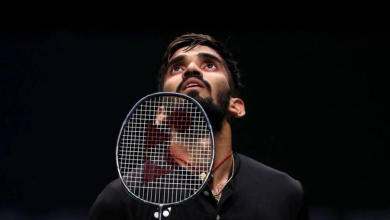Shami’s message to the world: Test match bowling works in T20 too

This IPL, there is little doubting Mohammed Shami’s intentions. Whereas his contemporaries have looked to bowl wide yorkers, camouflaged knuckleballs or slower ones that pop out from from fingers, palms or back of the hands, spread-fingers; Shami seems immune to all the clever charades.
He plays very straight. Even his slower one has an old-world charm to it: he gingerly holds the ball on the tip of his fingers as if he were twirling a flower, and releases it like a shuttler would do a cork.
Unlike Shami, most bowlers seem to be designing their bowling on what the batsmen will do and try to thwart their aggressive instincts. New ball swing bowlers have benefitted too from batsmen shaping to play the booming drives and failing. Not Shami. He has had them nicking, bowled, beaten, LBW largely trying to push-drive or defend even.
It’s probably harsh to shower the critical beam on Rahul Tripathi, but it opens a portal into Shami’s world. Tripathi is more than a decent batsman; displays flashes of brilliance, but often combusts due to wrong choices. This one time against Shami, though, he had no choice. He was fresh to the crease during a Powerplay, Shami’s world essentially, and received what seemed a slightly back-of-length proud-seam ball around off-stump.
Gujarat Titans’ Mohammed Shami, second left celebrates the wicket of Sunrisers Hyderabads’ Rahul Tripathi with teammates during the Indian Premier League cricket match between Gujarat Titans and Sunrisers Hyderabad in Ahmedabad, India, Monday, May 15, 2023. (AP Photo/Ajit Solanki)
Tripathi generally likes staying beside the line, and he attempts that. Make. In that tiny stutter of feet and head, the heavy ball has burst up explosively, and almost shoves Tripathi out of the way. Curbed for time and space, Tripathi has a panicky stab at it and finds it in the palms of the slip fielder. It was IPL, but it could have been Test cricket.
The other day there was a warm interaction between RP Singh and Shami on Jio Cinema. Singh asks the question swirling in everybody’s heads, “Shami, what change have you made this season that we are not able to see from here?” went RP. “Just one change this season; I have bowled so many balls in Tests before coming to IPL.” He laughs as he says “no other change”. Before IPL, acche sey ragad ke aaya hoon Tests mey (I have been battle-hardened in Tests).”
Simplicity does the trick
This T20 tournament was as good a place as any to understand the fuss about Shami’s Test-style bowling. There weren’t any dramatic visuals though. It’s their absence that, as ever, tells the Shami story. The ball just about dinks this way and that; a graphic in one of the highlights package shows he is getting 0.9 degree of movement, more than the 0.6 he got last year. Watching it in the Jio Cinema studio is Zaheer Khan, who is goaded into talking about the Shami mechanics Brett Lee. Zaheer is usually pretty reticent in talking details, but is moved to jump in with a few telling observations.
New Delhi: Gujarat Titans’ Mohammed Shami bowls during the IPL 2023 cricket match between Delhi Capitals and Gujarat Titans, at the Arun Jaitley Stadium in New Delhi, Tuesday, April 4, 2023. (PTI Photo/Ravi Choudhary)(PTI04_04_2023_000246A)
Like the grip on the seam. As Lee waxed on about the fingers on the seam and how Shami uses it to backspin the ball, running them down on the back of the ball at release, Zaheer cut in to say, how the thumb plays a crucial part in maintaining the seam straight, proud, and stop it from wobbling. “You lock the wr with the thumb,” Zaheer said, showing how the thumb slides inwards, on the seam, as opposed to being placed straight. In other words, the thumb isn’t directly under the index finger like with many bowlers, but tilted in, and placed under the middle finger. “This locks the wr and helps in keeping the seam straight … and that back-spin that you talked about.”
More replays ensued, before Zaheer’s second nugget popped up. “This IPL, I have noticed Shami uses the index finger more and he sort of pushes it in that direction (inward direction) when he wants to take the ball away from the left-hander.” The replays showed a hardly discernible finger-pushing movement. Even as Zaheer was talking, Shami took down a left-hander live on air, Rilee Rossouw.
Rossouw is another batsman who likes staying beside the line of the ball, and usually is on leg-stump guard. Shami backspins the ball on that line, with that index-finger push, and it begins to deviate rather late after Rossouw is already committed to pushing his bat down the leg-and-middle line, taking the edge through to the wicketkeeper.
“I always look to maintain good seam control and keep the movement of the wr to a minimum. Sometimes, bowlers would search for big movement and end up giving clues to batsmen. They can cut the fingers across the seam rather exaggeratedly or some such variations. But then, the batsmen can watch the movement of the wr and figure out whether it’s coming in or going away. But I like to keep the movement of my wrs to bare minimum, keep it straight as much as possible and look for (seam) movement off the surface,” Shami had told this newspaper.
India’s Mohammed Shami bowls a delivery during the first day of the second cricket test match between India and Australia in New Delhi, India, Friday, Feb. 17, 2023. (AP Photo/Altaf Qadri)
Knowing his game
Consider the wicket that had Shami celebrating the most this IPL: the dismissal of Jos Buttler. It was a classic Test vs T20 battle. Buttler had shuffled outside off for his famous lap shot, the stroke he deployed against Naseem Shah in the last T20 World Cup final after telling his bewildered partner Ben Stokes: “I can’t play him normally; so I am going to scoop him for a six”. Shami didn’t change his line or length to adjust to the shot, landing it on a length just outside off and nipping it back in. Buttler had adjusted but in the wrong direction, his bat was in place for that straightener or leg-cutter, but this one darted in to take out his off-stump, and Shami swirled around in delight.
It’s learnt that, more often than not, Shami hasn’t bowled in the nets leading up to games in this IPL. The cruiser knows his body, knows it’s primed up for battle, and has been strutting into games and doing his thing. “You should know body, power, skill … I have to decide whether I need practice, whether I need gym or not,” he said.
For decades now, Sunil Gavaskar has been saying a line about pacers: how there is no use for too much movement, just a bat’s width is necessary to take the edge. For a while, early in his career, it seemed S Sreesanth would be the bowler who Gavaskar could use as a demonstration tool, but he faded out. Shami is now that ideal.
For that bat-width theory to work, it helps that the ball rushes across rather straight. Shami’s deliveries don’t swerve in the air that much; there is no early swing, not even detectable seam alignment or angled releases. The ball almost cuts a straight path, lands, and then snips this way or other. And as the batsmen, unaware of the destination, play the line, the ball moves a bat-width to threaten both edges. Minimalism is at the soul of his bowling. In fact, the absence of the fingers cutting across the seam, that Shami talks about, almost gives the impression that he practises seam bowling as if he were bowling swing. Just the fingers back-spinning on the ball, but that tiny finger presses/pushes seem to be doing the work for him.
While his peers are plunging down passes, service roads, cul-de-sacs; Shami is cruising on the highway, in plain sight. Shami bowled Test-match style to run away with the rewards in a T20 tournament. No other pacer, then, is more prepared for the World Test Championship final.







